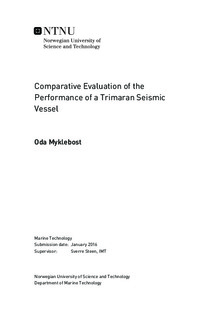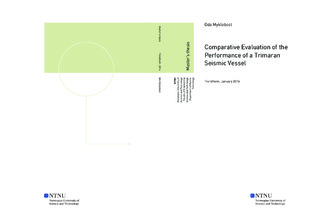| dc.description.abstract | The scope of this thesis is proposed by the naval architect and maritime engineering company LMG Marin. Currently, they are in the early design phase of a new trimaran concept intended for the seismic industry. This new trimaran concept differs from other trimaran ships in both purpose area and hull configuration. Therefore it is in the interest of LMG Marin and the project initiator, OilCraft AS, to investigate how this hull configuration will affect the trimaran's seakeeping behaviour. The design process of a multi-hull allows the designer to be creative in his decision of hull layout. Therefore, different hull configurations had to be assessed. The main purpose of this study is to verify the potential advantages of the trimaran concept. In addition, this work aims to provide an insight into how the design process should proceed with respect to the main particulars of the three hulls.
The wave-vessel interaction problem was solved by use of numerical tools. Because the flow around the adjacent hulls will be more complicated opposed to a conventional mono-hull, it was decided that 2D strip theory method is not sufficiently sophisticated to treat hydrodynamic hull interaction. As the design process is still in the development stage, model trials were not an option. CFD analysis would provide satisfactory amount of information about the flow. However, CFD analysis was not considered an option due to the author's lack of experience with such tools. It was found unrealistic to obtain enough experience to implement the models and carry out the analysis within the allocated time. A literal review of previous research work revealed that 3D potential panel methods can be a good option when analyzing multi-bodied floaters. Such methods are able to describe the reflection of waves between adjacent floaters. Therefore, it was decided to run the simulations in the DNV software Wasim, which is based on a Rankine panel method. The disadvantage of potential theory methods is that viscous effects are neglected, meaning that an important contribution to the wave damping is lacking. When a 3D potential theory method is used to analyse a trimaran, the amplitude of the trapped wave between the hulls will be highly overestimated close to the resonance frequency. As a consequence, the results corresponding to wavelengths in proximity to the resonance frequency have a poor credibility. However, it was found by empirical approximation that the gap wave natural periods will be small compared to the periods of interest. In other words, a 3D potential theory can be justified for moderate to high sea states.
As the trimaran concept is intended for the seismic industry, a set of criteria based on the vessel's purpose were defined. Hospitable working conditions are desired as the ship will be a platform where geophysicists and observers perform assignments that require a high level of precision. Therefore, criteria for motion sickness incidence are included. The ship is also a platform where crew operate seismic equipment and it is required that these tasks can be conducted safely. Therefore, a criterion concerning motion induced interruption of deck operations is included. As seismic surveys often last for very long periods, it is practical that the vessel can launch and recover a helicopter. For this reason, a helicopter operation criterion is included. Due to the additional hulls, it was found highly relevant to include the hydrodynamic hull interaction in the verification. All additional vibrations and noise will interrupt the seismic data quality. It is therefore important to avoid water impact on the cross-deck structure. It was not found any existing criteria specifically for seismic vessels. Therefore, a conventional seismic vessel has been included in the analysis for comparison.
Analysis problems were encountered when running simulations in Wasim in the case of forward speed. The gap wave amplitude increased without boundaries due to the lack of viscous damping. This was expected, but the solution strategy to exclude periods corresponding to the gap wave natural periods from the frequency set was not successful. Wasim models the incoming regular waves as a single irregular wave form, which makes it difficult to filter out the problematic frequencies. Therefore, an alternative plan was set: The criteria that are derived directly from the vessel's global motions were assessed by utilizing the 2D strip theory software Veres. The questions related to relative motion were answered based on Wasim results corresponding to zero forward speed.
Overall, it was found that the trimaran concept shows better seakeeping abilities than the comparison ship. The trimaran will be a more stable work platform in higher sea states. The disadvantage of this feature is that the trimaran has more prominent occurrence of motion induced interruptions (MII) during small sea states. Even then, the results are quite satisfying. The trimaran concept also showed good results with respect to motion sickness incidence (MSI). Most of the hull configurations that were assessed were superior to the mono-hull. A special feature of the hull configurations that were investigated in this work is that they have a very large beam. Also, the side hulls are very long compared to other trimarans and contribute to a large part of the total displacement. It was found that these attributes result in quite similar roll and pitch natural periods. This implies that the trimaran will show a "cork-screw" motion that is a characteristic of many catamarans. However, this can be avoided by making the side hulls shorter and half planing. Due to the analysis problems, it was difficult to make a definite conclusion regarding the relative motion between wave and vessel in the gap. However, the results imply that the tunnel height should be at least four meters to avoid cross-deck water impact. However, the results indicate that viscous effects will affect
the results and should be taken into account to obtain better results. It is therefore recommended to perform model tests to investigate the relative motion. The alternative is to perform an URANS-VOF simulation to include both viscous and rotational effects in the flow and free surface waves. | |

